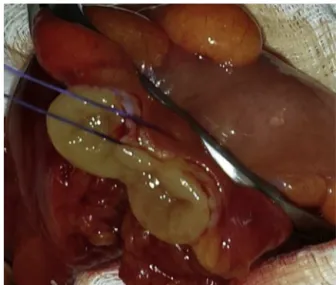jcoloproctol(rioj).2016;36(4):273–276
w w w . j c o l . o r g . b r
Journal
of
Coloproctology
Technical
Note
Scheduled
maturation
in
low
colorectal
and
coloanal
anastomoses
Rubens
Henrique
Oleques
Fernandes
a,baSociedadeBrasileiradeColoproctologia(SBCP),RiodeJaneiro,RJ,Brazil
bHospitalPompeia,DepartamentodeColoproctologia,CaxiasdoSul,RS,Brazil
a
r
t
i
c
l
e
i
n
f
o
Articlehistory:
Received20January2015 Accepted16October2016 Availableonline24October2016
Keywords: Rectalcancer
Colorectalanastomosis
Coloanalanastomosis
a
b
s
t
r
a
c
t
Introduction:Anastomotic dehiscence isthe maincomplicationafter lowcolorectaland coloanalanastomoses.Thetechniquescommonlyusedarethedouble-staplingand
hand-sewnanastomoses,botharemadewithimmediatematuration.Thesetechniquesdonot
preventpelvicsepsisinmanypatientsandarenotfeasibleinallcases.
Objective:Thestudyaimistoreportthetechnicaldetailsandresultswiththeuseof sched-uledmaturationanastomosisintenpatients.
Surgicaltechnique:Thescheduledmaturationanastomosisisdoneintwosteps.Thefirststep istheclosureofcolonicstumpinawaythatkeepsthemucosalayerinevertedposition.The secondstepistheunionofthecolonandrectumendsbytransanalaccess.Allthesutures aremadewith2/0polyglactin.Adivertingstomamustbedoneinallcases.After30days, beginsspontaneousopeningoftheanastomosis.
Results:Tenpatientsunderwentthistechnique.Thereweretwocasesofstenosisthatwere treatedwithdigitaldilatationinoffice.Allpatientshadtheirdivertingostomyclosed. Conclusion: Thescheduledmaturationanastomosisisfeasibleindifficultcasesandmay preventpelvicsepsisinlowcolorectalandcoloanalanastomoses.
©2016SociedadeBrasileiradeColoproctologia.PublishedbyElsevierEditoraLtda.This isanopenaccessarticleundertheCCBY-NC-NDlicense(http://creativecommons.org/ licenses/by-nc-nd/4.0/).
Maturac¸ão
programada
em
anastomoses
colorretais
baixas
e
coloanais
Palavras-chave: Câncerretal
Anastomosecolorretal
Anastomosecoloanal
r
e
s
u
m
o
Introduc¸ão: Adeiscênciaanastomóticaéa principalcomplicac¸ãoapósanastomoses
col-orretais baixasecoloanais.Astécnicascomumenteusadassãooduplogrampeamento
e aanastomosemanual, ambassãofeitas commaturac¸ãoimediata.Estastécnicasnão
impedemasepsepélvicaemmuitospacientesenãosãoexequíveisemtodoscasos. Objetivo:Oestudomostraosdetalhesdatécnicaeosresultadosdousodaanastomosecom maturac¸ãoprogramadaemdezpacientes.
E-mail:olequesfernandes@terra.com.br http://dx.doi.org/10.1016/j.jcol.2016.10.001
274
jcoloproctol(rioj).2016;36(4):273–276Técnica cirúrgica: A anastomosecommaturac¸ão programadaé feitaem duasetapas. A primeirafaseéofechamentodocotocólicocompontosquemantémamucosaevertida.A segundafaseéauniãodasextremidadesdocóloneretopelaviatransanal.Todasassuturas sãofeitascompoliglactina00.Umestomaparaderivac¸ãodeveserfeitoemtodososcasos. Após30dias,inicia-seaaberturaespontâneadaanastomose.
Resultados: Dezpacientes foram submetidos a estatécnica. Ocorreram dois casos de estenosequeforamtratadoscomdilatac¸ãodigitalemconsultório.Todospacientestiveram fechamentodesuaostomiadederivac¸ão.
Conclusão: Aanastomosecommaturac¸ãoprogramadaéfactívelemcasosdifíceisepode prevenirasepsepélvicaemanastomosescolorretaisbaixasecoloanais.
©2016SociedadeBrasileiradeColoproctologia.PublicadoporElsevierEditoraLtda.Este ´eumartigoOpenAccesssobumalicenc¸aCCBY-NC-ND(http://creativecommons.org/ licenses/by-nc-nd/4.0/).
Introduction
Managementoflowrectaltumorsremainsachallenge.The
morbidity and mortality of surgery are quite associated
withanastomoticfailure.Theshorteningofdistalresection
margin,1 total mesorectal excision,2 neoadjuvant therapy3
andthe intersphinctericresectiontechnique4 arethe main
factorstoincreasesphincterpreservationincancerofthe dis-talrectum.
The most employed techniques for low colorectal and
coloanalanastomosisarethedouble-staplingandtransanal
hand-sewnanastomoses.However,thesetechniquesdonot
preventthatupto25%ofpatientsunderwentsphincter-saving surgeryforrectalcancerpresentwithanastomoticfailureand haveadefinitestoma.5Afterthefailureofknownanastomotic
techniquesinredosurgerywedevelopeda newtechnique,
namedscheduledmaturationanastomosis.
Theaimofthisstudyistoreportourpreliminary experi-encebyusingthistechniquein10consecutivepatients.
Materials
and
methods
FromJune2011toFebruary 2014,10patientswereselected
tothistechniqueofanastomosis.Theideaofusingthis tech-niquearoseduringthesurgeryofthefirstcase,aredosurgery
ina 42 years old woman. In this case it was not possible
toperformthetechniquesalreadyknown,duetoadhesions,
fibrosis andstrictureofthe rectalstump.Theanastomosis
wasperformedwithscheduledmaturation asalastoption
toreversethecolostomy.Thepostoperativeoutcomewasvery good,whatmotivatedtheindicationofthistechniquetoother selectedcases.
From there were three more cases of redo surgery,
three intersphincteric resections and three low colorectal
anastomosis.Allpatientswereintreatmentforrectal adeno-carcinoma.
Thestudy was approvedbyour localethics committee.
Informedconsentwasobtainedfromallpatients,exceptthe
first.
Demographic and pathological data are summarized in
Table1.
Table1–Patientdemographicsandpathology.
Sex
Male 6
Female 4
Age,mean,y 31–75,54.6
Anastomoticdistancefromaverage,mean,cm 2.0–6.0,3.6
Preoperativeadjuvanttherapy 8
Tumorstage
I 1
II 5
III 4
Surgicaltechnique
Patientsunderwentaroutinemechanicalbowelpreparation andwereplacedinLloyd-Davisposition.Thecolontobe low-eredmusthaveenoughlengthforatension-freeanastomosis. Thescheduledmaturationanastomosisismadeintwosteps. Thefirststepistoclosethecolonicstump,thiscanbedone byabdominalortransanalapproach.Thecolonisclosedwith interruptedsuturesof2/0polyglactin910,themucosalayer mustbekeptinevertedposition(Fig.1).Thesuturesaremade every 3–4mmtoensuretheabsenceofleakage(Fig.2).The
second stepisalwaysdone bytransanalaccess.Therectal
jcoloproctol(rioj).2016;36(4):273–276
275
Fig.2–Finalappearanceaftercolonicclosure.
stumpmustbewashedwithsaline.Thecolonicextremityis
thenpulledandpositionedagainsttherectalstump(Fig.3).
Theunionofthestumpsismadewith4or5sutures,
leav-ingthemuntieduntiltheyhavebeencorrectlyplaced.Each
suturetakesadeepbiteoftheposteriorrectalborder,traverse thefullthicknessofthecolonandtakesanotherbiteofthe anteriorrectalborder.Totiethesuturesisnecessarytopull theretractorslightly.Fig.4showsthelastsuturetobetied.
Whentherectumhasalargerdiameterthanthecolon,the
surplusisclosed.Theleaktestwasnotperformed.After fin-ishingtheanastomosis,adivertingileostomyorcolostomyis performed.
Normallyin30–40daysaftersurgerybeginsspontaneous
openingoftheanastomosis.
Theanastomosis surveillance ismade by digital
exam-ination and anoscopy in the office. Fig. 5 shows the final
appearanceofthisanastomotictechnique.
Fig.3–Positioningthecolonend.
Fig.4–Tyingthelastsuture.
Results
Inalloperatedpatientstheanastomosiswasperformed
suc-cessfully. Patientswere dischargedbetween thefourth and
eighthpostoperativeday.Therewerenosepticcomplications.
Thefirstsixpatients wereevaluated withabdominalX-ray
toinvestigatepossiblegaseousdistentionofthecolon
with-out drainage throughthe ileostomy,inall, thepresenceof
smallamountofgasinthecolonwasnoticed.Somepatients
reportedsmall gaseliminationafterthe30thpostoperative
day.Therewasnoreadmission.
Two of the patients, who underwent intersphincteric
resection, had moderated stenosisof the anastomosis and
weretreatedwithdigitaldilatationintheoffice.Allpatients hadtheirdivertingstomaclosed.
Discussion
Therewassuspicionthattheclosedcoloncoulddistendbygas inpatientswithdivertingileostomy,inthisseriesthecolonic contentremainedinert,thisconfirmsthetheorythat,without
276
jcoloproctol(rioj).2016;36(4):273–276thesupplyofsubstrate,thebacterialgrowthandthe produc-tionofgasareceased.6
Thisnewtechniquemaynotbedone withoutdiversion,
but,evenifastapledanastomosisisperformed,atemporary divertingstomamustbeformedduringrectalexcisionandlow colorectalanastomosis,assuggestedinarandomizedstudy.7
Afterlowanastomosisdehiscence,somepatientsareleftwith
permanentostomy,becausethetechniquescurrentlyusedare
notfeasibleinallcases.Lefevreetal.8studiedredosurgeryin
33patients,therateofpelvicsepsiswas27%,intwopatients
theredosurgerywasimpossibletoperformduetomultiple
adhesionsanddifficultieswiththepelvicdissectionleading toabladderinjury.Inourfourcasesofredosurgery,theway
toopentherectumstumpwasusingabougie,wedidnotneed
todissecttotallythebladderfromtherectalstump.The dis-sectionmustbedoneuntilthecolonicandrectalstumpshave
similarwidths.Thisnewtechniqueappearstobefeasiblein
anycircumstancebecausetheunionofthetwoendsismade
withafewsutures,justforpositioning.Themaneuversthat ensurenopelvicsepsisaretheproperclosureofthecolonic stumpandcleaningoftherectalstump.
Inverylow-lyingrectalcancersthedistalresection
mar-ginisbestgivenbysectioningthe rectumunder transanal
approachandtheanastomosisismadeinahand-sewn
man-ner. The techniques we have already used are the Park’s
technique9andthesimplesuturewithoutmucosectomy.The
newtechniqueseemseasiertodoandworkswellwhenthe
two extremities have different diameters. If using colonic
pouchorcoloplasty,theanastomosismaybedoneinthesame
wayasstraightanastomosis.
Thetwocasesofstrictureinthisserieswerein
anastomo-sisatthepectinline, thepromptimprovementwithdigital
dilatationsuggestthatnosepsisoccurredintheanastomotic area.
The technique with maturation delay, described by
Turnbull10 and Cutait,11 wasevaluated bymany authors.It
demandssplenicflexuredissection,alongerhospitalstayand areoperation.Theincidenceofcomplications,likesepticand colonicnecrosis,mayhavecauseditslittleusecurrently.The impossibilityofpullingthecolonthroughafibroticanalcanal inourfirstcasewaswhatinspiredmetodothetechniqueI amdescribinghere.
Conclusion
The use of scheduled maturation in low colorectal and
coloanalanastomosisisfeasibleindifficultcases.This
tech-niqueseemstopreventpelvicsepsisbymaintainingcolonic
contents withoutcontact withthe healingarea ofthe two
ends. Surelythis studyhasthe limitationofsmall number
ofpatients.There isaneedforother seriestovalidatethe feasibilityandresultsofthistechnique.
Conflicts
of
interest
Theauthordeclaresnoconflictsofinterest.
Acknowledgements
TheauthorthankstoDr.EdsonBaronandDr.Eduardo
Bram-billabyrecommendingtheirspatientsforthistechnique.
r
e
f
e
r
e
n
c
e
s
1.UenoH,MochizuchiH,HashiguchiY,IshikawaK,FujimotoH, ShintoE,etal.Preoperativeparametersexpandingthe indicationofsphincterpreservingsurgeryinpatientswith advancedlowrectalcancer.AnnSurg.2004;239:34–42. 2.HealdRJ,HusbandEM,RyallRD.Themesorectuminrectal
cancersurgery–thecluetopelvicrecurrence?BrJSurg. 1982;69:613–6.
3.MinskyBD,CohenAM,EnkeWE,PatyP.Sphincter preservationwithpreoperativeradiationtherapyand coloanalanastomosis.IntJRadiatOncolBiolPhys. 1995;31:553–9.
4.SchiesselR,Karner-HanuschJ,HerbstF,TelekyB,Wunderlich M.Intersphinctericresectionforlowrectaltumors.BrJSurg. 1994;81:1376–8.
5.denDulkM,SmitM,PeetersKC,KranenbargEM,RuttenHJ, WiggersT,etal.Amultivariateanalysisoflimitingfactorsfor stomareversalinpatientswithrectalcancerenteredintothe totalmesorectalexcisionexcision(TME)trial:aretrospective study.LancetOncol.2007;8:297–303.
6.CruzGMG.Fisiologiadointestinogrosso.In:CruzGMG, editor.Coloproctologia:PropedêuticaGeral.1sted.Editora Revinter:RiodeJaneiro;1999.p.33–45.
7.MatthiessenP,HallböökO,RutegardJ,SimertG,SjödahlR. Defunctioningstomareducessymptomaticanastomotic leakageafterlowanteriorresectionoftherectumforcancer: arandomizedmulticentertrial.AnnSurg.2007;246:207–14. 8.LefevreJH,BretagnolF,MaggioriL,FerronM,AlvesA,PanisY.
Redosurgeryforfailedcolorectalorcoloanalanastomosis:a valuablesurgicalchallenge.Surgery.2011;149:65–71. 9.ParksAG.Transanaltechniqueinlowrectalanastomosis.
ProcRSocMed.1972;65:975–8.
10.TurnbullRB,CuthbertsonA.Abdominorectalpull-through resectionforcancerandforHirschprung’sdisease.Delayed posteriorcolorectalanastomosis.CleveClinQ.
1961;28:109–15.

